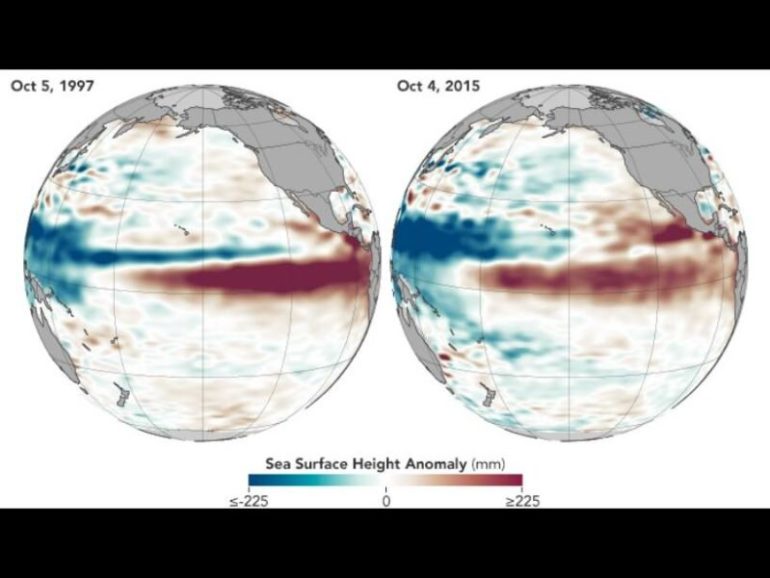Much like the oceans, the atmosphere on Earth oscillates on a global scale. The so-called atmosphere tides depend on the Sun’s heat and gravity, as well as the pull of the Moon and Earth’s own rotation. In the troposphere, scientists have identified a regular tide, which they call DW1, that has a 24-hour period and a zonal wave number of 1. Zonal wave number refers to the number of troughs and peaks that can be observed simultaneously in a wave as it circles the entire globe, meaning in this case that there is only one of each.
Researchers have known for several decades that DW1 exists in large part because of heating related to tropospheric water vapor, which then propagates up into the mesosphere and lower thermosphere. During the 2015 El Niño, scientists saw an anomalously large enhancement of DW1.
In a new study, Kogure and Liu sought to explain the cause of that enhancement by investigating two potential drivers. First, they looked at the effect of enhanced tropospheric tidal heating caused by El Niño. However, the team reported the 2015 El Niño event had increased heating by 0.4 milliwatt per kilogram, which equates to only an extra 5%. In turn, the team says, 5% more tropospheric heating could explain only 7% of the thermal tide enhancement.
The other 93% comes from a reduction in dissipation in the atmosphere. As soon as DW1 begins to propagate, it also begins to dissipate as the air it’s pushing into drags against it, which is part of the natural life cycle of the tide. However, during the 2015 El Niño, wind impacts on the thermal tide were greatly reduced, causing less dissipation and a net enhancement of DW1. Specifically, the researchers suggest that quasi-biennial oscillation (QBO) in the lower stratosphere can account for the reduced dissipation by suppressing the vertical wavelength and wind shear in the northward direction. The QBO explains how equatorial zonal winds shift from easterlies to westerlies in the stratosphere roughly every two years. The 2015 El Niño corresponded to an eastward QBO phase, which the researchers say created the favorable conditions for the enhanced thermal tide.
Distinctive MJO activity during 2015/2016 super El Nino
More information:
Masaru Kogure et al, DW1 Tidal Enhancements in the Equatorial MLT During 2015 El Niño: The Relative Role of Tidal Heating and Propagation, Journal of Geophysical Research: Space Physics (2021). DOI: 10.1029/2021JA029342
Provided by
American Geophysical Union
This story is republished courtesy of Eos, hosted by the American Geophysical Union. Read the original story here.
Citation:
Explaining thermal tides in the upper atmosphere during the 2015 El Niño (2021, August 27)
retrieved 30 August 2021
from https://phys.org/news/2021-08-thermal-tides-upper-atmosphere-el.html
This document is subject to copyright. Apart from any fair dealing for the purpose of private study or research, no
part may be reproduced without the written permission. The content is provided for information purposes only.



